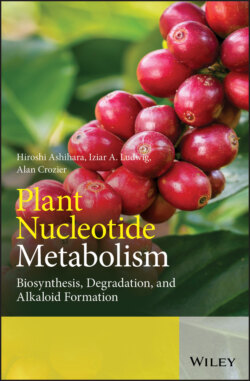Читать книгу Plant Nucleotide Metabolism - Hiroshi Ashihara - Страница 36
3.2 De Novo Biosynthesis of Ribonucleoside Monophosphates
ОглавлениеIn many organisms including plants, ribonucleotides are synthesized from precursors derived from amino acids, sugar phosphates, and carbon dioxide. De novo synthesis of purine, pyrimidines, and the ring of pyridine (nicotinamide adenine) nucleotides are synthesized via three distinct pathways. It is noteworthy that the initial products are nucleotides, namely inosine-5′-monophosphate (IMP), orotidine-5′-monophosphate (OMP) and nicotinate mononucleotide (NaMN), but not nucleosides or nucleobases. The de novo pathways of nucleotide biosynthesis are summarized in Figure 3.1. In the case of purine nucleotides, IMP is synthesized from 5-phosphoribosyl-1-pyrophosphate (PRPP) (Figure 3.1a). The carbon and nitrogen atoms of the purine ring come from multiple sources. Glycine contributes all its carbon and nitrogen atoms (positions 4, 5, and 7 of a purine ring), with additional nitrogen atoms from glutamine (positions 3 and 9) and aspartate (position 1), and further carbon atoms from formyl groups (positions 2 and 8), which are transferred from the coenzyme tetrahydrofolate as 10-formyltetrahydrofolate, and a carbon atom from bicarbonate (position 6). A detailed biochemical and molecular analysis of purine biosynthesis in plants has yet to be carried out, but the enzymatic steps are similar to those occurring in microorganisms and animals. More details of the 14 enzymatic steps involved in adenosine monophosphate (AMP) and GMP production from PRPP are presented in Part II.
Figure 3.1 The major pathways of de novo biosynthesis of purine, pyrimidine and pyridine nucleotides. Detailed pathways are shown in Part II, III, and IV, respectively. (a) Purine ribonucleotide biosynthesis: abbreviations of metabolites are as follows: PRPP, 5-phosphoribosyl-1-pyrophosphate; PRA, 5-phosphoribosyl amine; GAR, glycineamide ribonucleotide; FGAR, formylglycineamide ribonucleotide; FGRAM, formylglycine amidine ribonucleotide; AIR, 5-aminoimidazole ribonucleotide; CAIR, 5-aminoimidazole 4-carboxylate ribonucleotide; SCAIR, 5-aminoimidazole-4-N-succinocarboxyamide ribonucleotide; AICAR, 5-aminoimidazole-4-carboxyamide ribonucleotide; FAICAR, 5-formamidoimidazole-4-carboxyamide ribonucleotide; SAMP, adenylosuccinate; XMP, xanthosine-5′-monophosphate. The participated enzymes are (1) PRPP amidotransferase (2.4.2.14); (2) GAR synthetase (6.3.4.13); (3) GAR formyl transferase (2.1.2.2); (4) FGAM synthetase (6.3.5.3); (5) AIR synthetase (6.3.3.1); (6) AIR carboxylase (4.1.1.21); (7) SAICAR synthetase (6.3.2.6); (8) adenylosuccinate lyase (4.3.2.2); (9) AICAR formyl transferase (2.1.2.3); (10) IMP cyclohydrolase (3.5.4.10); (11) SAMP synthetase (6.3.4.4); (12) adenylosuccinate lyase (4.3.2.2), the same enzyme for step 8; (13) IMP dehydrogenase (1.1.1.205); (14) GMP synthetase (6.3.5.2). (b) Pyrimidine ribonucleotide biosynthesis: CP, carbamoyl phosphate; CA, carbamoyl aspartate; DHO, dihydroorotate; OA, orotate; OMP, orotidine-5′-monophosphate. Enzymes: (1) aspartate transcarbamoylase (2.1.3.2); (2) dihydroorotase (3.5.2.3); (3) dihydroorotate dehydrogenase (1.3.99.11); (4)–(5) UMP synthase (orotate phosphoribosyltransferase [2.4.2.10] plus orotidine-5′-phosphate decarboxylase [4.1.1.23]). (C) Pyridine ribonucleotide biosynthesis: Asp, aspartate; ISA, α-iminosuccinate; QA, quinolinate; NaMN, nicotinate mononucleotide; NaAD; nicotinate adenine dinucleotide. Enzymes: (1) L-aspartate oxidase (1.4.3.16); (2) quinolinate synthase (2.5.1.72); (3) quinolinate phosphoribosyltransferase (decarboxylating) (2.4.2.19); (4) nicotinate mononucleotide adenylyltransferase (2.7.7.18); (5) NAD synthase (6.3.5.1).
Compared to purine biosynthesis, the pyrimidine biosynthetic pathway (aka the orotate pathway), namely the formation of uridine monophosphate (UMP) from carbamoyl phosphate, is more straight forward. The pathway consists of six reactions and the precursors are carbamoyl phosphate, aspartate, and PRPP (Figure 3.1b). Pyrimidine nucleotide biosynthesis, which is the same in plants as other organisms, is evolutionarily conserved in all species examined to date. Since nitrogen in carbamoyl phosphate is synthesized from glutamine, the nitrogen atoms of positions 1 and 3 of pyrimidine ring are derived from aspartate and glutamine, respectively. The carbon atoms at position 2 and positions 4–6 of the ring originate from carbon dioxide and aspartate (see Part III).
Pyridine nucleotides (nicotinamide adenine dinucleotide [NAD] and nicotinamide adenine dinucleotide phosphate [NADP]) consist of two mononucleotides, namely AMP and nicotinamide mononucleotide (NMN). Since the AMP moiety is a product of purine biosynthesis, in a narrow sense, pyridine nucleotide synthesis results in the formation of nicotinate monophosphate (NaMN). Two distinct pathways called the ‘aspartate pathway’ and the ‘kynurenine pathway’ occur in different organisms. The aspartate pathway, in which aspartate, glutamine, glyceraldehyde-3-phosphate and PRPP are used as precursors, operates in plants (Figure 3.1c). This route is also found in most bacteria, including Escherichia coli. In contrast, mammals, fungi, and some bacteria produce NAD by the kynurenine pathway. The steps leading from quinolinate to NAD are conserved among prokaryotes and eukaryotes. Further details of these biosynthetic pathways are covered in Part IV.
